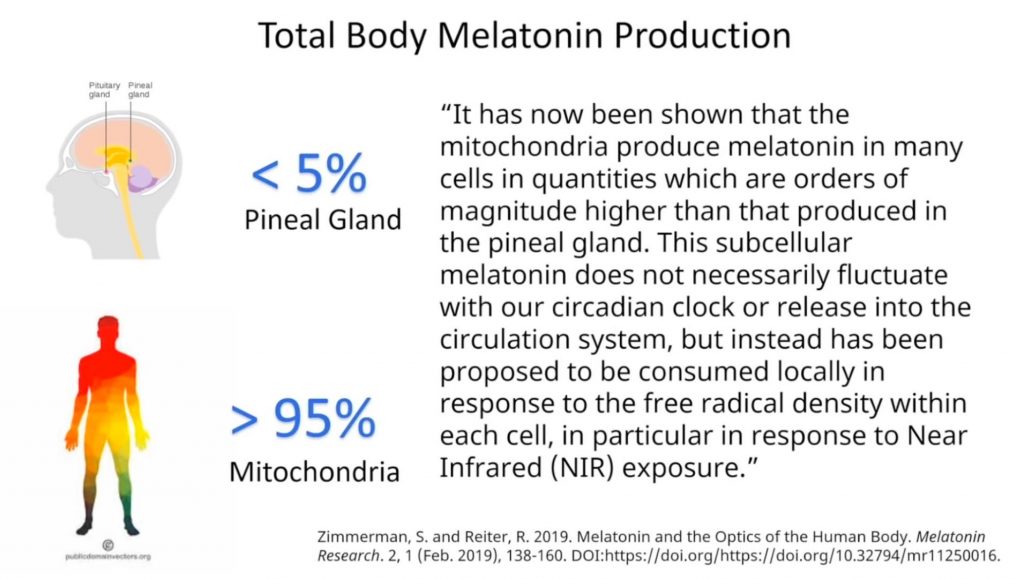Highlights:
- 95% of melatonin in your is made inside your mitochondria (via Cytochrome C) in response to near-infrared radiation (NIR) from the sun.
- Only 5% of melatonin is produced in your pineal gland at night.
- Mitochondria are the powerhouse of our cells for energy production (in the form of ATP). Lots of free radicals are also produced as byproducts. Excessive free radicals, if not neutralized promptly, will cause damage to mitochondria and other cellular structures.
- Mitochondrial dysfunction is observed in most, if not all, chronic diseases, esp. cancers, neurodegenerative diseases (Alzheimer’s, Parkinson’s), cardiovascular diseases, autoimmune diseases and diabetes.
- Melatonin is a powerful antioxidant. Melatonin and other antioxidants, such as Vit C, Vit E and glutathione, protect the health of mitochondria and other cellular structures by neutralizing these excessive and harmful free radicals (reactive oxygen species, ROS).
- Unfortunately, we usually don’t take melatonin during the day as it will make you sleep. So we need to get exposure to sunshine. Good news is that the NIR portion of sunshine is highly penetrable. You don’t need to necessarily be directly under the sun. Even in the shade, under the tree or around lots of green plants, you’ll get lots of NIR radiation. [1]
- Regular sunshine exposure not only increases your Vit D3 levels, but also your melatonin.
We all know by now that Vit D3 is critical for your health, not just for your bone health, but also for the overall health, including your immunity. During this Covid-19 pandemic, there’s been much scientific research that shows low Vit D3 levels are highly correlated with the high infection and mortality rates of Coivd-19. We have been asking you to get more sunshine in order to boost your immunity. Melatonin is one of the powerful antioxidants that we have been promoting for the fight against Covid-19.
We all thought melatonin is produced at night in the pineal gland and when the sun is up and your eyes are exposed to the light, melatonin production stops. New research begins to show that actually the melatonin produced in the pineal gland is only a very small portion of the total melatonin in your body, only 5% to be exact. 95% of melatonin is actually produced in your cells (in mitochondria, the powerhouse of your cells), under the near infrared (NIR) light in the sunshine. [2]
Melatonin (from the Pineal Gland):
- Melatonin protects against cancer via multiple pathways
- WHO classifies circadian disruptive shift work as a probable carcinogen (Group 2A).
- Reduced cancer incidence in “totally” blind people (due to lack of melatonin production inhibition by light in these people). [3]
Melatonin has potent antioxidant activity
- Melatonin is produced within mitochondria in response to sunlight and provides targeted protection of mitochondria from free radicals.
- Mitochondria is protective against a range of diseases characterized by mitochondrial dysfunction, including cancers, neurodegenerative diseases, cardiovascular diseases, autoimmune diseases and diabetes. Practically mitochondrial abnormality is found in most if not all chronic diseases where such research has been done.
- Melatonin may play a role in the prevention and treatment of Alzheimer’s and Parkinson’s diseases (oxidative stress appears to be a key mechanism) and even in Covid-19. [4]
References:
- Twohig-Bennett C, Jones A. The health benefits of the great outdoors: A systematic review and meta-analysis of greenspace exposure and health outcomes. Environ Res. 2018 Oct;166:628-637. doi: 10.1016/j.envres.2018.06.030. Epub 2018 Jul 5. PMID: 29982151; PMCID: PMC6562165.
- Zimmerman S. and Reiter, R. 2019. http://www.melatonin-research.net/index.php/MR/article/view/19
- Feychting M, Osterlund B, Ahlbom A. Reduced cancer incidence among the blind. Epidemiology. 1998 Sep;9(5):490-4. PMID: 9730026.
- Reiter RJ, Ma Q, Sharma R. Melatonin in Mitochondria: Mitigating Clear and Present Dangers. Physiology (Bethesda). 2020 Mar 1;35(2):86-95. doi: 10.1152/physiol.00034.2019. PMID: 32024428.
- https://www.youtube.com/watch?v=5YV_iKnzDRg&t=4530s

